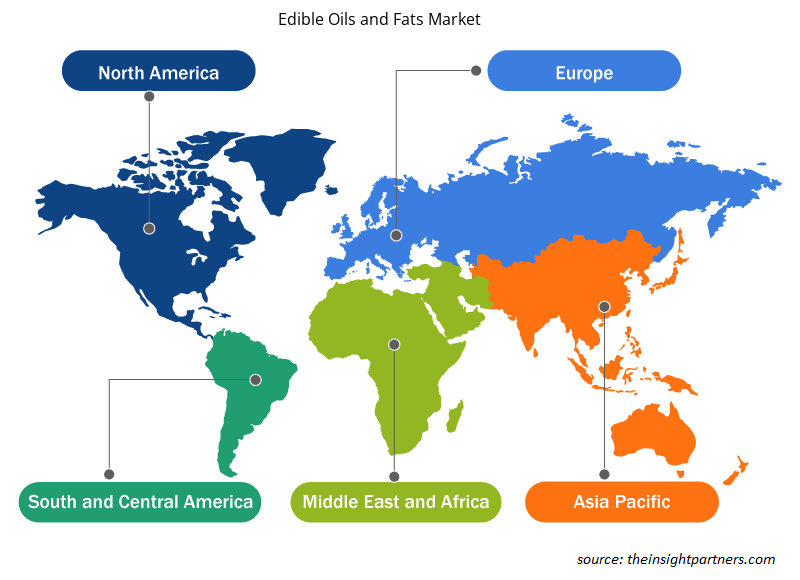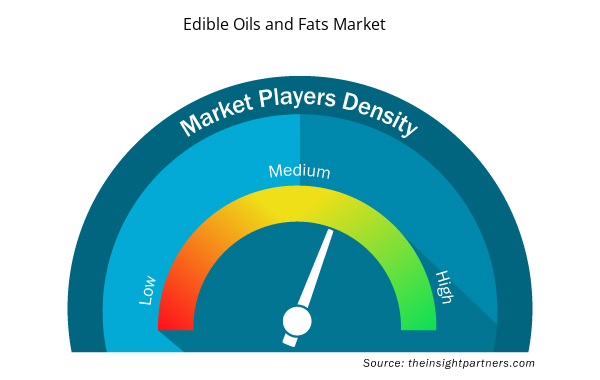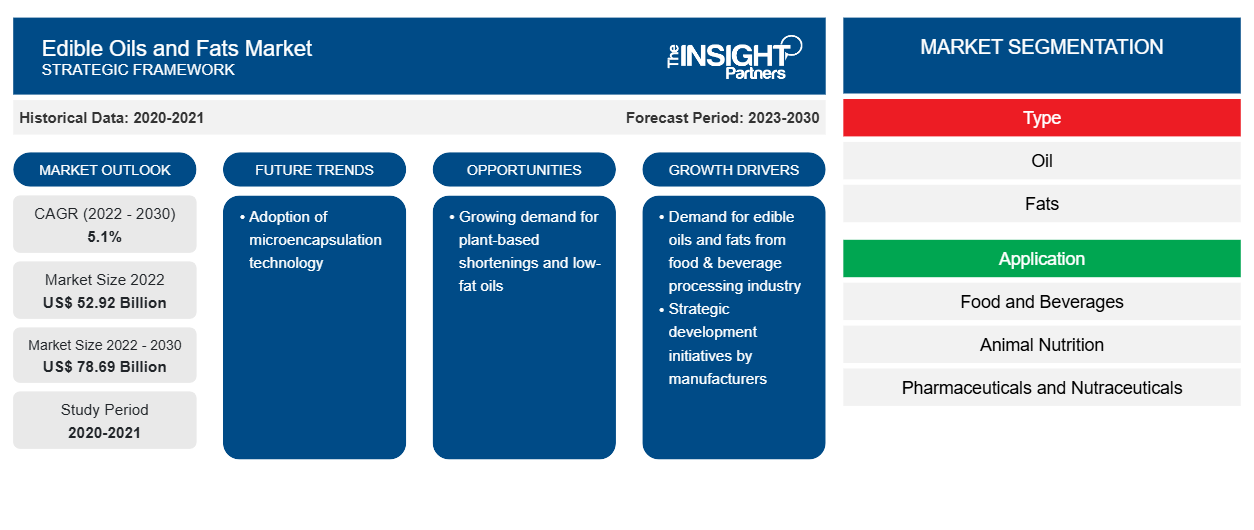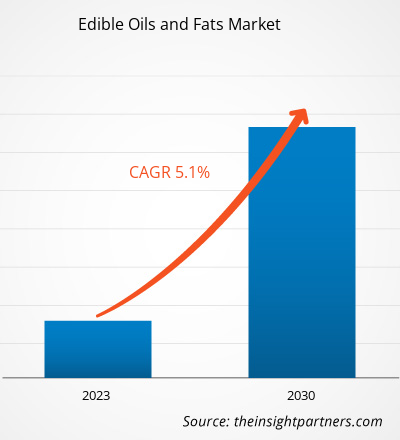[연구보고서] 식용유지 시장은 2022년 529억2,000만달러에서 2030년 786억8,661만달러로 성장할 것으로 예상되며, 2023년에서 2030년까지 연평균 성장률 5.1%를 기록할 것으로 예상됩니다.
시장 통찰력 및 분석가 관점:
식용 지방은 돼지기름(라드)과 탤로우와 같은 동물성 원료나 식물성 원료를 통해 얻습니다. 육류 가공업체는 식용 동물성 지방 제조업체의 원료 공급업체입니다. 제조업체는 육류 가공 산업과 원료를 중단 없이 공급하기 위한 장기 계약을 맺습니다. 돼지고기나 소고기의 지방 조직은 작은 조각으로 잘게 자르고 증기 소화조에서 끓입니다. 여기서 지방은 물에 방출됩니다. 지방은 수면 위로 떠서 스키밍으로 수집합니다. 동물 조직의 막질 물질은 유압 프레스에서 압착하여 추가 지방을 얻습니다. 지방은 슬러지 제거 원심분리기에서 액체 상태에서 분리됩니다.
마가린과 같은 식물성 지방은 대두유, 옥수수유 또는 홍화유의 수소화에 의해 얻어진다. 기름은 먼저 표백토 또는 숯으로 표백하여 바람직하지 않은 냄새와 색상을 제거한다. 그런 다음 고압 하에 수소 가스를 통과시켜 기름을 응고시켜 마가린을 얻는다. 식물성 기름과 지방을 제조하는 데는 다양한 공정이 있다.
정제된 식용 오일과 지방은 용기에 포장되어 유통업체와 공급업체를 통해 식품 및 음료, 동물 영양, 제약 및 건강기능식품 산업과 같은 최종 사용자에게 배송됩니다. Cargill Incorporated, Bunge Limited, ADM, Fuji Oil Co Ltd, Kao Corporation은 전 세계적으로 식용 오일과 지방의 주요 제조업체 중 일부입니다.
성장 동인 및 과제:
미국 농무부(USDA)에 따르면 대두유는 두 번째로 많이 소비되는 식물성 기름입니다. 튀김, 조리, 쇼트닝, 마가린에 광범위하게 사용됩니다. 경제협력개발기구(OECD)에 따르면 2022년 식물성 기름 소비량은 2억 4,900만 톤에 달했으며, 식품 부문이 가장 큰 비중을 차지했습니다. 게다가 제과 산업은 버터를 주요 성분으로 상당히 활용하고, 그 다음은 마가린입니다. 고품질 식용유와 지방은 제빵 및 제과, 유제품 및 냉동 디저트, 간식, 바로 먹을 수 있는(RTE) 및 바로 조리할 수 있는(RTC) 식사, 기타 식품 및 음료에 사용됩니다. 정제된 기름과 지방은 지질의 풍부한 공급원입니다. 따라서 응용 분야가 증가하고 세계 인구가 증가함에 따라 사용이 증가하고 있습니다.
북미와 아시아 태평양과 같은 다양한 지역의 식품 및 음료 산업은 지속 가능성에 대한 급증하는 경향, 편의성 및 바로 먹을 수 있는 제품에 대한 선호도, 유기농 및 식물성 제품의 증가로 인해 지속적으로 성장하고 있습니다. 이 산업은 빠르게 변화하는 소비자 선호도에 부응하기 위해 프로세스, 제품 및 서비스의 혁신으로 상당한 움직임을 목격하고 있습니다. 미국 인구조사국에 따르면 미국은 2020년에 39,646개의 식품 및 음료 제조 공장을 보유하고 있었습니다. 그 중 캘리포니아, 텍사스 및 뉴욕은 각각 6,116개, 2,625개 및 2,600개를 보유하고 있습니다. 마찬가지로 식품 및 음료 산업은 유럽 경제에 크게 기여하는 산업 중 하나입니다. 따라서 전 세계적으로 성장하는 식품 및 음료 산업은 식용 오일과 지방에 대한 수요를 촉진합니다.
귀하의 요구 사항에 맞게 이 보고서를 사용자 정의하세요
이 보고서의 일부 또는 국가 수준 분석, Excel 데이터 팩을 포함하여 모든 보고서에 대한 사용자 정의를 무료로 받을 수 있으며 신생 기업 및 대학을 위한 훌륭한 혜택과 할인 혜택을 이용할 수 있습니다.
- 이 보고서의 주요 시장 동향을 알아보세요.이 무료 샘플에는 시장 동향부터 추정 및 예측까지 다양한 데이터 분석이 포함됩니다.
보고서 세분화 및 범위:
"글로벌 식용유 및 지방 시장 "은 유형, 응용 분야 및 지리적 위치에 따라 세분화됩니다. 유형에 따라 시장은 오일과 지방으로 나뉩니다. 응용 분야에 따라 글로벌 식용유 및 지방은 식품 및 음료, 동물 영양, 제약 및 건강 보조 식품으로 나뉩니다. 오일 세그먼트는 글로벌 시장에서 더 큰 점유율을 차지했습니다.
식용유지 시장
2022년에 식용유 및 지방 시장은 지리적으로 북미(미국, 캐나다, 멕시코), 유럽(독일, 프랑스, 이탈리아, 영국, 러시아, 유럽의 나머지 지역), 아시아 태평양(호주, 중국, 일본, 인도, 한국, 아시아 태평양의 나머지 지역), 중동 및 아프리카(남아프리카, 사우디 아라비아, UAE, 중동 및 아프리카의 나머지 지역), 남중부 아메리카(브라질, 칠레, 남중부 아메리카의 나머지 지역)로 세분화됩니다.
세그먼트 분석:
식용유와 지방 시장은 유형에 따라 오일과 지방으로 나뉩니다. 오일 세그먼트는 2022년 식용유와 지방 시장에서 더 큰 점유율을 차지했으며 예측 기간 동안 더 높은 CAGR을 기록할 것으로 예상됩니다. 식물성 오일은 씨앗, 곡물, 견과류 및 과일에서 얻을 수 있습니다. 올리브, 해바라기, 팜, 카놀라, 코코넛, 홍화, 옥수수, 땅콩, 면실, 팜핵 및 대두유는 가장 많이 소비되는 오일 중 일부입니다. 일반적으로 식물성 오일은 식품 준비에 사용되고 원유는 풍미를 위해 추가됩니다. 식물성 오일은 또한 동물 사료 생산에도 사용됩니다. 팜유는 안정화하기 쉽고 가공 식품에서 풍미 품질과 일관성을 유지합니다. 따라서 식품 제조업체에서 자주 선호합니다. 인도네시아, 말레이시아, 태국 및 나이지리아는 가장 큰 팜유 생산자 및 수출국 중 일부입니다. 수소화 식물성 오일의 트랜스 지방과 관련된 건강 문제에 대한 인식이 높아짐에 따라 식품 산업에서 팜유 사용이 촉진됩니다. 농식품 산업은 팜유의 상당한 소비자로, 주로 산업용 제빵류, 초콜릿 제품, 과자, 아이스크림, 심지어 다이어트 식사 대용품에 사용되기 때문입니다. 팜유는 토코페롤과 카로티노이드의 풍부한 공급원으로, 산화적 열화에 대한 자연적 안정성을 제공합니다. 따라서 다양한 최종 사용 산업에서 팜유의 이점과 용도가 전 세계적으로 수요를 촉진합니다.
지역 분석:
식용유 및 지방 시장은 북미, 유럽, 아시아 태평양, 남미 및 중미, 중동 및 아프리카의 5개 주요 지역으로 세분화됩니다. 글로벌 식용유 및 지방 시장은 남미 및 중미가 주도했으며 2022년에는 약 4조 5,000억 달러로 추산되었습니다. 남미 및 중미의 식용유 및 지방 시장은 브라질, 아르헨티나, 그리고 남미 및 중미의 나머지 지역으로 세분화됩니다. 이 지역의 간식 식품 부문은 냉동 간식, 짭짤한 간식, 과일 간식, 과자 간식, 베이커리 간식과 같은 다양한 간식 옵션에 대한 소비자 선호도가 높아짐에 따라 확대되고 있습니다. 식용유 및 지방은 음식에 독특한 풍미를 제공하고 간식을 제조하는 데 독특하고 바람직한 기능을 제공하므로 필수적인 역할을 합니다. 예를 들어, 기름은 튀긴 음식의 튀김 매체이며, 페이스트리에서는 밀가루와 기타 재료가 뭉치는 것을 방지하기 위해 식물성 기름 기반 쇼트닝을 첨가합니다. 따라서 다양한 간식에 대한 수요가 증가하고 식용유와 지방이 지닌 이점으로 인해 남미와 중미의 간식 부문에서 식용유와 지방에 대한 수요가 증가하고 있습니다.
또한 동물 영양과 같은 최종 사용 산업에서 식용 유지에 대한 수요는 남미와 중미에서 증가했습니다. Oil World에 따르면, 2022년에 중국은 브라질 대두유의 약 70%를 주로 동물성 단백질 소비를 위해 구매했습니다. 또한 동물 영양, 제약 및 건강기능식품 산업의 확대로 인해 특수 식용 유지에 대한 수요가 증가하고 있습니다. 이러한 산업은 동물 사료 제형 및 제약 제형과 같이 다양한 용도에 특정 유형의 오일이 필요합니다. 이러한 부문이 성장하고 다양화됨에 따라 고유한 요구 사항에 대한 수요가 증가하여 남미와 중미의 식용 유지 시장 성장을 촉진합니다.
산업 발전 및 미래 기회:
글로벌 식용유 및 지방 시장에서 활동하는 주요 기업이 취한 다양한 이니셔티브는 아래와 같습니다.
- 2021년 10월, 미국의 대표적인 식용 유지 제조업체 중 하나인 ADM은 식품 및 사료 산업에서 빠르게 증가하는 대두유 수요를 충족하기 위해 노스다코타에 최초의 전용 대두 분쇄 공장과 정유 공장을 건설할 계획이라고 발표했습니다.
- 2021년 12월, 일본에 본사를 둔 ITOCHU Corporation은 미국 뉴욕에 본사를 둔 ITOCHU International Inc.를 통해 미국에 Fuji Oil International Inc.를 설립하기로 합의했다고 발표했습니다. 이 합의를 통해 회사는 북미에서 오일 및 지방 사업을 강화할 계획입니다.
식용유 및 지방 시장 지역 통찰력
Insight Partners의 분석가들은 예측 기간 동안 식용유 및 지방 시장에 영향을 미치는 지역적 추세와 요인을 철저히 설명했습니다. 이 섹션에서는 북미, 유럽, 아시아 태평양, 중동 및 아프리카, 남미 및 중미의 식용유 및 지방 시장 세그먼트와 지리에 대해서도 설명합니다.

- 식용유 및 지방 시장에 대한 지역별 특정 데이터 얻기
식용유 및 지방 시장 보고서 범위
| 보고서 속성 | 세부 |
|---|---|
| 2022년 시장 규모 | 529억 2천만 달러 |
| 2030년까지 시장 규모 | 786억 9천만 달러 |
| 글로벌 CAGR (2022-2030) | 5.1% |
| 역사적 데이터 | 2020-2021 |
| 예측 기간 | 2023-2030 |
| 다루는 세그먼트 | 유형별로
|
| 포함된 지역 및 국가 | 북아메리카
|
| 시장 선도 기업 및 주요 회사 프로필 |
|
시장 참여자 밀도: 비즈니스 역학에 미치는 영향 이해
식용유 및 지방 시장은 소비자 선호도의 변화, 기술 발전, 제품의 이점에 대한 인식 증가와 같은 요인으로 인해 최종 사용자 수요가 증가함에 따라 빠르게 성장하고 있습니다. 수요가 증가함에 따라 기업은 제품을 확장하고, 소비자의 요구를 충족하기 위해 혁신하고, 새로운 트렌드를 활용하여 시장 성장을 더욱 촉진하고 있습니다.
시장 참여자 밀도는 특정 시장이나 산업 내에서 운영되는 회사나 기업의 분포를 말합니다. 주어진 시장 공간에 얼마나 많은 경쟁자(시장 참여자)가 존재하는지 그 규모나 총 시장 가치에 비해 나타냅니다.
식용유와 지방 시장에서 활동하는 주요 회사는 다음과 같습니다.
- 번지 유한회사
- 아처-대니얼스-미들랜드 카운티
- 후지 오일 주식회사
- 카오 주식회사
- 아케이에이치에이치에이
면책 조항 : 위에 나열된 회사는 어떤 특별한 순서에 따라 순위가 매겨지지 않았습니다.

- 식용유 및 지방 시장의 주요 주요 업체 개요를 알아보세요
COVID-19 팬데믹 영향:
COVID-19 팬데믹은 다양한 국가의 경제와 산업에 영향을 미쳤습니다. 북미, 유럽, 아시아 태평양(APAC), 남미 및 중미, 중동 및 아프리카(MEA)의 주요 국가에서 봉쇄, 여행 금지 및 사업 중단은 식품 및 음료 산업을 포함한 다양한 산업의 성장에 부정적인 영향을 미쳤습니다. 제조 단위의 폐쇄는 글로벌 공급망, 제조 활동, 납품 일정 및 다양한 필수 및 비필수 제품의 판매를 방해했습니다. 다양한 회사에서 2020년에 제품 납품이 지연되고 향후 제품 판매가 침체될 가능성이 있다고 발표했습니다. 또한 유럽, 아시아 및 북미의 다양한 정부가 국제 여행에 대한 금지 조치를 취하면서 회사는 협력 및 파트너십 계획을 일시적으로 보류해야 했습니다. 이러한 모든 요인이 2020년과 2021년 초에 식품 및 음료 산업을 방해하여 식용유 및 지방 시장의 성장을 제한했습니다.
경쟁 환경 및 주요 회사:
Bunge Ltd, Archer-Daniels-Midland Co., Fuji Oil Co Ltd, Kao Corp, AAK AB, J-Oil Mills Inc, Cargill Inc, Olam Group Ltd, ConnOils LLC, Louis Dreyfus Co BV는 글로벌 식용유 및 지방 시장에서 활동하는 대표적인 기업입니다. 이러한 식용유 및 지방 제조업체는 혁신적인 기능을 갖춘 최첨단 추출 솔루션을 제공하여 소비자에게 뛰어난 경험을 제공합니다.
- 역사적 분석(2년), 기준 연도, CAGR을 포함한 예측(7년)
- PEST 및 SWOT 분석
- 시장 규모 가치/양 - 글로벌, 지역, 국가
- 산업 및 경쟁 환경
- Excel 데이터 세트


- Hot Melt Adhesives Market
- Queue Management System Market
- Battery Testing Equipment Market
- HVAC Sensors Market
- Saudi Arabia Drywall Panels Market
- Aircraft Wire and Cable Market
- Passport Reader Market
- Electronic Toll Collection System Market
- Small Internal Combustion Engine Market
- Semiconductor Metrology and Inspection Market

Report Coverage
Revenue forecast, Company Analysis, Industry landscape, Growth factors, and Trends

Segment Covered
This text is related
to segments covered.

Regional Scope
North America, Europe, Asia Pacific, Middle East & Africa, South & Central America

Country Scope
This text is related
to country scope.
자주 묻는 질문
Manufacturers of edible fats and oils invest significantly in the expansion of business and production capacity to serve their customer base better and meet their consumer requirements. In December 2021, ITOCHU Corporation, headquartered in Japan, announced their agreement through ITOCHU International Inc., headquartered in New York, US, for the establishment of Fuji Oil International Inc. in the US. With this agreement, the firm plans to strengthen the oil and fat business in North America.
Based on type, oil segment mainly has the largest revenue share. Vegetable oils can be derived from seeds, cereal grains, nuts, and fruits. The most consumed oils are olive, sunflower, palm, canola, coconut, safflower, corn, peanut, cottonseed, palm kernel, and soybean. Generally, vegetable oils are used in food preparation, and crude oil is added for flavor. Vegetable oil is also used in the production of animal feed.
The major players operating in the global edible oils and fats market are are Bunge Ltd, Archer-Daniels-Midland Co, Fuji Oil Co Ltd, Kao Corp, AAK AB, J-Oil Mills Inc, Cargill Inc, Olam Group Ltd, ConnOils LLC, and Louis Dreyfus Co BV.
Consumers consider plant-based products healthier than conventional products. Rising health consciousness among consumers propels the demand for plant-based and low-fat products. Thus, manufacturers develop plant-based shortenings and low-fat oils to cater to the rising demand. Plant-based shortenings are non-hydrogenated and do not contain cholesterol and trans-fat. Thus, it is considered a healthier alternative to conventional shortenings. Moreover, the increasing prevalence of cardiovascular diseases, obesity, and diabetes over the years is expected to boost the demand for low-fat products such as low-fat oils among various industries, including bakery & confectioneries, dairy & frozen desserts, and snacking.
Asia Pacific accounted for the largest share of the global edible oils and fats market. The market growth is attributed to increasing demand for bakery products, especially breads, cakes, pastries, and muffins, coupled with the growing influence of Western culture on the millennial and Gen-z population in the region. The bakery sector in China witnessed tremendous growth, with retail sales of bakery products accounting for US$ 34 billion in 2020, according to the United States Department of Agriculture (USDA). Moreover, manufacturers of edible oils and fats actively operate across the region and offer edible oils and fats made with fine-quality oil or its fractions. Distinct melting profiles of butter and margarines, packaging types, and the expansion of antifoaming or antioxidant agents of edible oils and fats are available across the region and widely applicable in many end-use industries such as confectionery, bakery, dairy, and infant nutrition.
Based on the application, food and beverages segment is hold a significant share in the market. The demand for edible oils and fats, such as shortenings, is gradually increasing in bakery and confectionery segment as they lubricate the structure of bakery products and shorten or tender flour proteins. Fats and oils in the mixture hold many air cells incorporated during creaming, making the products smooth and creamy. Fats act as enriching agents, add calorie value to baked foods, and develop flakiness in products. The rising demand for baked products, including cakes, breads, cookies, and biscuits, significantly drives edible oils and fats utilization.
Trends and growth analysis reports related to Food and Beverages : READ MORE..
The List of Companies - Edible Oils and Fats Market
- Bunge Ltd
- Archer-Daniels-Midland Co
- Fuji Oil Co Ltd
- Kao Corp
- AAK AB
- J-Oil Mills Inc
- Cargill Inc
- Olam Group Ltd
- ConnOils LLC
- Louis Dreyfus Co BV
The Insight Partners performs research in 4 major stages: Data Collection & Secondary Research, Primary Research, Data Analysis and Data Triangulation & Final Review.
- Data Collection and Secondary Research:
As a market research and consulting firm operating from a decade, we have published and advised several client across the globe. First step for any study will start with an assessment of currently available data and insights from existing reports. Further, historical and current market information is collected from Investor Presentations, Annual Reports, SEC Filings, etc., and other information related to company’s performance and market positioning are gathered from Paid Databases (Factiva, Hoovers, and Reuters) and various other publications available in public domain.
Several associations trade associates, technical forums, institutes, societies and organization are accessed to gain technical as well as market related insights through their publications such as research papers, blogs and press releases related to the studies are referred to get cues about the market. Further, white papers, journals, magazines, and other news articles published in last 3 years are scrutinized and analyzed to understand the current market trends.
- Primary Research:
The primarily interview analysis comprise of data obtained from industry participants interview and answers to survey questions gathered by in-house primary team.
For primary research, interviews are conducted with industry experts/CEOs/Marketing Managers/VPs/Subject Matter Experts from both demand and supply side to get a 360-degree view of the market. The primary team conducts several interviews based on the complexity of the markets to understand the various market trends and dynamics which makes research more credible and precise.
A typical research interview fulfils the following functions:
- Provides first-hand information on the market size, market trends, growth trends, competitive landscape, and outlook
- Validates and strengthens in-house secondary research findings
- Develops the analysis team’s expertise and market understanding
Primary research involves email interactions and telephone interviews for each market, category, segment, and sub-segment across geographies. The participants who typically take part in such a process include, but are not limited to:
- Industry participants: VPs, business development managers, market intelligence managers and national sales managers
- Outside experts: Valuation experts, research analysts and key opinion leaders specializing in the electronics and semiconductor industry.
Below is the breakup of our primary respondents by company, designation, and region:

Once we receive the confirmation from primary research sources or primary respondents, we finalize the base year market estimation and forecast the data as per the macroeconomic and microeconomic factors assessed during data collection.
- Data Analysis:
Once data is validated through both secondary as well as primary respondents, we finalize the market estimations by hypothesis formulation and factor analysis at regional and country level.
- Macro-Economic Factor Analysis:
We analyse macroeconomic indicators such the gross domestic product (GDP), increase in the demand for goods and services across industries, technological advancement, regional economic growth, governmental policies, the influence of COVID-19, PEST analysis, and other aspects. This analysis aids in setting benchmarks for various nations/regions and approximating market splits. Additionally, the general trend of the aforementioned components aid in determining the market's development possibilities.
- Country Level Data:
Various factors that are especially aligned to the country are taken into account to determine the market size for a certain area and country, including the presence of vendors, such as headquarters and offices, the country's GDP, demand patterns, and industry growth. To comprehend the market dynamics for the nation, a number of growth variables, inhibitors, application areas, and current market trends are researched. The aforementioned elements aid in determining the country's overall market's growth potential.
- Company Profile:
The “Table of Contents” is formulated by listing and analyzing more than 25 - 30 companies operating in the market ecosystem across geographies. However, we profile only 10 companies as a standard practice in our syndicate reports. These 10 companies comprise leading, emerging, and regional players. Nonetheless, our analysis is not restricted to the 10 listed companies, we also analyze other companies present in the market to develop a holistic view and understand the prevailing trends. The “Company Profiles” section in the report covers key facts, business description, products & services, financial information, SWOT analysis, and key developments. The financial information presented is extracted from the annual reports and official documents of the publicly listed companies. Upon collecting the information for the sections of respective companies, we verify them via various primary sources and then compile the data in respective company profiles. The company level information helps us in deriving the base number as well as in forecasting the market size.
- Developing Base Number:
Aggregation of sales statistics (2020-2022) and macro-economic factor, and other secondary and primary research insights are utilized to arrive at base number and related market shares for 2022. The data gaps are identified in this step and relevant market data is analyzed, collected from paid primary interviews or databases. On finalizing the base year market size, forecasts are developed on the basis of macro-economic, industry and market growth factors and company level analysis.
- Data Triangulation and Final Review:
The market findings and base year market size calculations are validated from supply as well as demand side. Demand side validations are based on macro-economic factor analysis and benchmarks for respective regions and countries. In case of supply side validations, revenues of major companies are estimated (in case not available) based on industry benchmark, approximate number of employees, product portfolio, and primary interviews revenues are gathered. Further revenue from target product/service segment is assessed to avoid overshooting of market statistics. In case of heavy deviations between supply and demand side values, all thes steps are repeated to achieve synchronization.
We follow an iterative model, wherein we share our research findings with Subject Matter Experts (SME’s) and Key Opinion Leaders (KOLs) until consensus view of the market is not formulated – this model negates any drastic deviation in the opinions of experts. Only validated and universally acceptable research findings are quoted in our reports.
We have important check points that we use to validate our research findings – which we call – data triangulation, where we validate the information, we generate from secondary sources with primary interviews and then we re-validate with our internal data bases and Subject matter experts. This comprehensive model enables us to deliver high quality, reliable data in shortest possible time.


 이 보고서에 대한 무료 샘플을 받으세요
이 보고서에 대한 무료 샘플을 받으세요